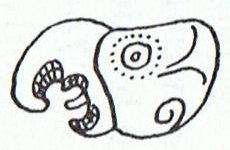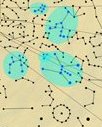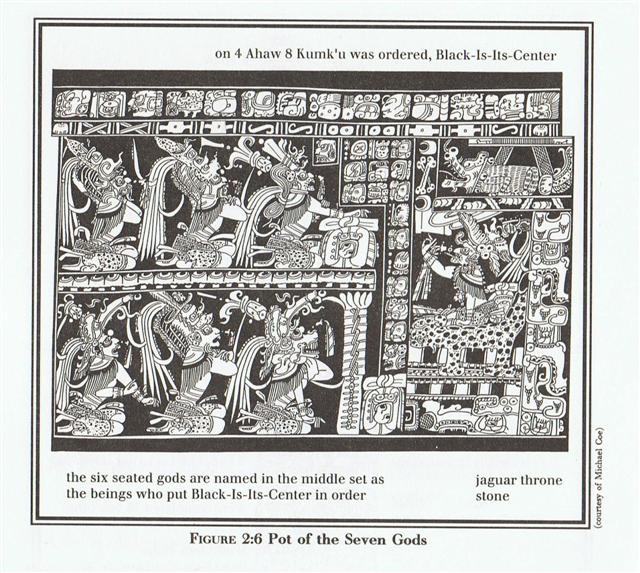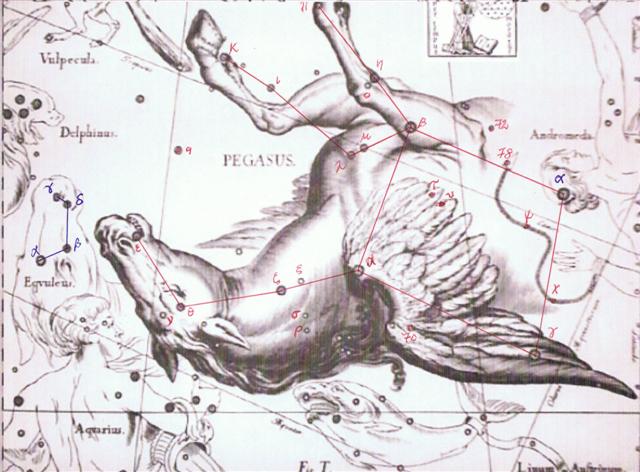The instrument for shooting down the vainglorious Seven Macaw - who once upon a time thought he was the Sun - was not bow and arrow but a blow-gun for pellets (suitable for reaching the 'stones', the stars in the night):
In the center of this Mayan panorama is the cosmic tree with the glorious vain bird in its crown. The eye of Seven Macaw resembled the Chinese sign for Sirius:
But the top of the cosmic tree was high up in contrast to the low position of Sirius. And in the center of the orbit of Seven Macaw there was not a dot but an eye. We should therefore think of a position at the opposite side of the year compared to Puppis - corresponding to the Babylonian Bow - which was curved instead of straight as the barrel of the blowgun. ... Freeman describres the dualistic cosmology of the Pythagorean school (-5th century), embodied in a table of ten pairs of opposites. On one side there was the limited, the odd, the one, the right, the male, the good, motion, light, square and straight. On the other side there was the unlimited, the even, the many, the left, the female, the bad, rest, darkness, oblong and curved ...
... This pot depicts one of the Hero Twins (One-Ahaw in the Classic texts and One-Hunaphu in the K'iche' Popol Vuh) and a great bird who is trying to land in a huge ceiba tree heavy with fruit. This mythical bird is Itzam-Yeh, Classic prototype of Wuqub-Kaqix, 'Seven-Macaw', of Popol Vuh fame. In that story, in the time before the sky was lifted up to make room for the light, the vainglorious Seven-Macaw imagined himself to be the sun. Offended by his pride, the Hero Twins humbled him by breaking his beautiful shining tooth with a pellet from their blowgun. This pot shows One-Ahaw aiming at the bird as he swoops down to land in his tree. As Itzam-Yeh lands on his perch, the text tells us he is 'entering or becoming the sky'.
This particular 'sky-entering' is not the one mentioned in the Palenque text. It is the final event that occurred in the previous creation before the universe was remade. Before the sky could be raised and the real sun revealed in all its splendor, the Hero Twins had to put the false sun, Itzam-Yeh, in his place. If the date on this pot corresponds to that pre-Creation event, as we believe it does, then Itzam-Yeh was defeated in 12.18.4.5.0 1 Ahaw 3 K'ank'in (May 28, 3149 B.C.). After the new universe was finally brought into existence, First Father also entered the sky by landing in the tree, just as Itzam-Yeh did ... ... In three magnificent texts at the site of Koba, scribes recorded it as one of the largest finite numbers we humans have ever written. According to these inscriptions, our world was created on the day 4 Ahaw 8 Kumk'u. On this day all the cycles of the Maya calendar above twenty years were set at thirteen ...
In our calendar, this day fell on August 13, B.C. 3114 ... To understand what this means, we need a little scale. The thirteens in this huge number act like the twelve in our cycles - the next hour after twelve is one. Thirteen changed to one as each of these cycles in the Maya calendar was completed, therefore, we have the following sequence:
Each of the years, called a tun by the Maya, in these dates is composed of 360 days. If we return to the Creation date with its twenty cycles set at thirteen, we see that it will take 41,943,040,000,000,000, 000,000,000,000 tuns for the highest cycle to change from thirteen to one ... We can count the precessional distance down to the time when the previous creation ended: A.D. 1842 (time of rongorongo) + 3149 B.C. (defeat of Seven Macaw) = 4991 years and 4991 / (26000 / 365¼) = ca 70 right ascension days. Therefore the date given as May 28 should correspond to a position among the stars around 70 days earlier than that at the time of rongorongo. 148 (May 28) - 70 = 78 (March 19). 3149 B.C. (end of previous creation) - 3114 B.C. (beginning of the present creation) = 35 years or ca half a right ascension day. August 13 (225) - 69 = 156 (June 5) = 78 (March 19) + 78. The synodic cycle of Mars was 780 days.
At the time of rongorongo heliacal Sirius was in right ascension day *101 (June 30) with φ Sagittarii at the Full Moon (*284):
Throughout all these 4991 years Sirius should in principle have stood still (viz. in heliacal June 30 respectively in nakshatra December 30). ... The Sothic cycle was based on what is referred to in technical jargon as 'the periodic return of the heliacal rising of Sirius', which is the first appearance of this star after a seasonal absence, rising at dawn just ahead of the sun in the eastern portion of the sky. In the case of Sirius the interval between one such rising and the next amounts to exactly 365.25 days - a mathematically harmonious figure, uncomplicated by further decimal points, which is just twelve minutes longer than the duration of the solar year ... But the fixed stars in the background would have shifted and at the time of rongorongo they would have moved to positions around 70 nights later. 181 (June 30) + 70 = 251 (September 8):
The vainglorius Seven Macaw could evidently have been defeated just before nightside Sirius reached the Full Moon.
|
|||||||||||||||||||||||||||||||||||||||||||||||||||||||||||||||||||||||||||||||||||||||||||||||||||||||||||||||||||||||||||||||||||||||||||||||||||||||||||||||||||||||||||||||||||||||||||||||||||||||||||||||||||||||||||||||||||||||||||||||||||||||||||||||||||||||||||||||||||||||||||||||||||||||||||||||||||||||||||||||||||||||||||||||||||||||||||||||||||||||||||||||||||||||

















